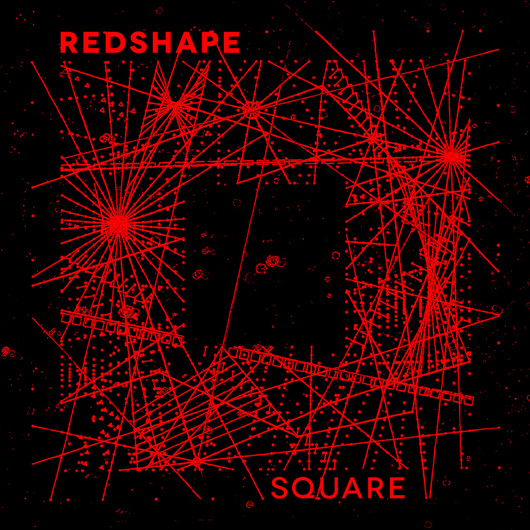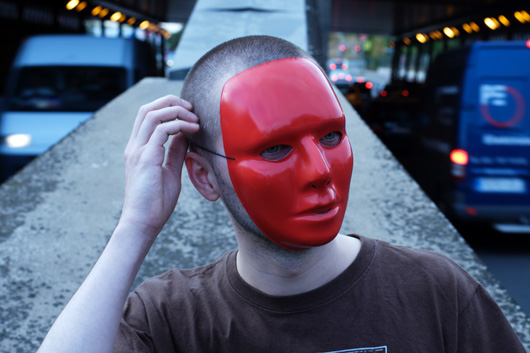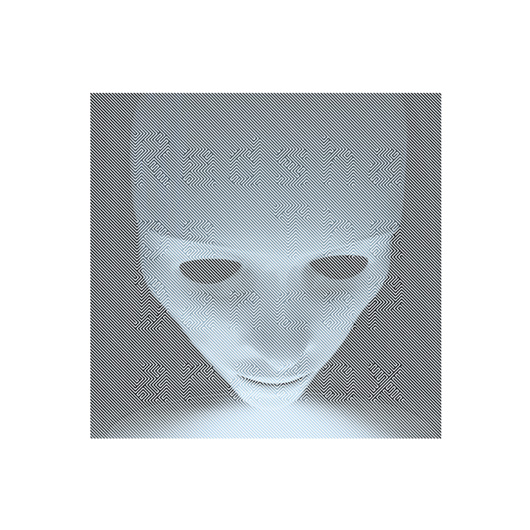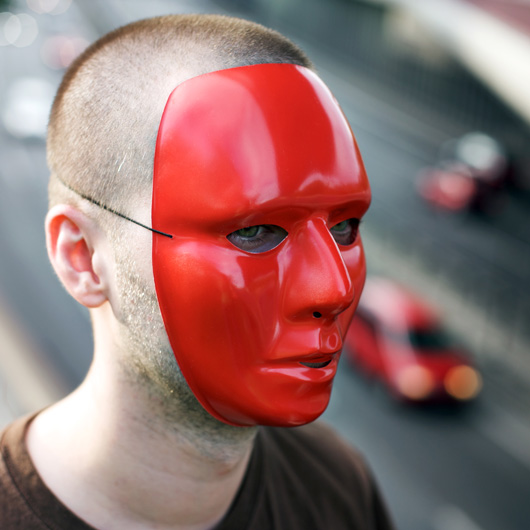Deep Inside: Redshape ‘Square’
As a ritual item, masks are a universal human fascination. These objects may be simple, […]

Deep Inside: Redshape ‘Square’
As a ritual item, masks are a universal human fascination. These objects may be simple, […]

As a ritual item, masks are a universal human fascination. These objects may be simple, yet they possess a transformative potential that’s as powerful as it is mysterious. Tribal rites in places as far flung as West Africa and Bali use masks as vehicles of temporary possession, seeing them as crucial for the performance of ceremony. To don the mask in such a situation is to be freed of previous identity, history, and personality—but this comes at the price of playing a subservient role to an inhabiting alien presence. This is something that Sebastian Kramer discovered when he first put on the creepy red mask that would come to define Redshape, the production alter ego that has dominated his output for the past six years.
Prior to 2006, Kramer had been a successful producer under his own name, with a discography of singles rooted in the tough and loopy sound of late-’90s techno. For example, his 2004 LP, Principles & Tactics, was described by XLR8R as, “a whopping 60 minutes of mechanical repetition and four-to-the-floor hypnosis.” Once he put on the mask though, Kramer was no longer himself; instead, he was some kind of entity brought to life, the spirit of techno’s past born into the physical world, a musical version of the computer-generated Puppet Master from Ghost in the Shell.
Square

Slowing the tempo down and letting his less brutal tendencies emerge, his early Redshape productions—like the mammoth “Unfinished Symmetry”—all pointed towards a Detroit reference point that bore an uncanny resemblance to the works of Carl Craig. In contrast, his album work has so far been irreverent, pushing against the boundaries of expectation and dancefloor appeal to strive for something less heavy. In 2009, Kramer released The Dance Paradox, his debut album as Redshape and an LP that tempered its harder edges with live percussion, downtempo flourish, and a dose of jazz. And while that record was experimental, it was nowhere near as divergent from his body of work as Square, the latest Redshape LP, which is being released via Germany’s Running Back imprint. Yet within its ambient excursions and moments of late-’90s backpacker hip-hop, it also manages to be Kramer’s most consciously plotted release to date, with a strong internal narrative that could almost be described as being cinematic in scope.
“I’m really interested in albums in general,” says Kramer through a playful German accent. “Like in every kind of music—especially rock albums or even hip-hop albums. I’ve wanted to achieve such an album, but done with the methods of electronic production. Brian Eno for example was a big influence for me, as well as DJ Shadow, old Moodymann stuff, and Carl Craig.” For Kramer, the reason that Square feels so internally cohesive is because it was intended that way. In his mind, the LP isn’t a collection of tracks compiled, but is rather a thought-out narrative spread across 12 segments. He explains, “I wanted to take my abilities and the techno way of doing things, but produce something which could stand on its own.”

Perhaps the most immediately striking thing about Square is the inclusion of ambient passages “Orange Clouds,” “Landing,” and “Departing.” Like tonal wormholes, they sit in the spaces between, serving as blocks of solid music that generate a monumental amount of space through algorithmic reverb. Too long to be interludes and too short to be songs, they are the cables that patch things together. In fact, Kramer says the album was born from its ambient pieces, which were in turn created from both a respect for ambient music as well as a desire to replicate the tape-based experiments of Brian Eno and Robert Fripp. From there, it was a matter of letting the ambient works dictate the direction of the album. “If I produced a track, I always put it in chain with the ambient pieces and if it didn’t fit the mood, then I’d throw it away and try something else,” he says before adding, “which is maybe why it’s less abstract or experimental with harsh sounds. It’s more fluid for some reason. That’s why it’s easier to understand than music I’ve done before. I wanted it to be very easy to follow.”
This effort is aided by the LP’s overall sense of cinematic scope. There’s an indebtedness to the screen that peeks out from the corners: dialogue from Depression-era Hollywood in “It’s in Rain,” the video sheen and coastal imagery of “Atlantic,” and the hardly veiled titular homage of “Enter the Volt.” But it’s also in the album’s overall structure, as its ambient pieces conveniently slice the record into consumable acts. Yet if Square was a film, it wouldn’t be a Hollywood picture; instead, it would be shot in the first person and disturbing in nature, something strange like Gaspar Noé’s Enter the Void. Much like that movie’s floating vantage point, Square offers a procession of moments that lead the listener far away from the established identity of Redshape, only to return again at its end.
The Dance Paradox

Coincidentally, Enter the Void served as inspiration for the album’s darkest moment. “Enter the Volt” is a disturbing journey into bleak industry, one where dissonant swells and a randomly generated machine scream shimmer above a stripped-down beat. The feeling it gives is a deliberate kind of gut-level wrenching, with Kramer’s voice echoing over waves of disturbed shadows and saying, “Hello?/I’m lost/Where are you?/Somebody?/I don’t see anything.” It marks the album’s furthest depths, the precise inspiration behind it so heavy that Kramer prefers not to comment, saying instead, “I was thinking of Enter the Void. The camera, the neon lights, the dark atmosphere of the film, together with that sex thing. I wanted to put all that weirdness in one track.” Underscoring that unsettling feeling is the music itself, which he says features a “fixed scale with a computer generating notes randomly between two octaves.” It’s a technique that’s employed throughout the LP and is used as a point of contrast against the various passages and layers that were more deliberately composed.
Square is a record of many contrasts, and if “Enter the Volt” marks its darkest point, then “Atlantic” represents its lightest. Kramer explains, “I was watching a movie, Snow Falling on Cedars. That is kind of a good movie for me, I was thinking that it’s really nice, really harmonic. So when it was over, I went into the studio and began playing that breakbeat and also the seagull, which is actually a rimshot from the Tempest.” Inspired by coastal cinematography, the song is a transoceanic flight spurred on by digital bird calls and undulating samples of waves. It would almost sound like Drexciya, save for the fact that its rhythm is so loose; it’s all toms and flanged cymbals, an open, above-water journey instead of a claustrophobic, electro-funk descent. “Atlantic” also contrasts in the sense that it features dynamic, live-played elements. He says, “The bassline is a 32-bar bassline I played live on the Moog, and it gives a harmonic direction to the whole track for the pads—which are all Oberheim SEM. I wanted it to have a really nice moment, because when I was finished with the track it was spring. I really liked to listen to the track in the car when it was really sunny. I don’t always have a connection to my tracks, but with ‘Atlantic,’ I do have that connection, because I myself know what it should trigger.”
“Starsoup” offers the album’s most straightforward cut for the dancefloor. The last song to be composed for Square, it stands out from the rest in the sense that it’s the only one that feels club ready. This can be traced in part to its genesis, as the inspiration for the song came from a track Kramer heard during an extended set by Daphni. “He was playing a marathon set for like eight hours or something,” explains Kramer. “He was playing one track—I tried to write it down, but I put down the wrong record. It had that arpeggio break and I thought, ‘Wow, that’s great. I want to do a track like this as well.'” He’s emphatic when talking about his intentions behind the song, “I remember when Dance Paradox came out, people were moaning, ‘Why is there no track like “Unfinished Symmetry” or a long track we could all play on it?’ And I thought, ‘Okay guys, this time I will put a track you can all play on it.'” Yet this doesn’t mean that “Starsoup” is divorced from the internal narrative of the LP. Once again, the film influence returns, with repeated blurts of dialogue and crowd noise repeating in the background like runaway tape machines while a hollow analog synthesizer traces angular shapes over a constantly lurching kick drum.
If “Starsoup” is the record’s most accessible moment, then easily its most challenging comes towards the LP’s end with “Until We Burn.” Compared with this song, the rest of the album feels rather safe, as “Until We Burn” explores turn-of-the-millenium backpacker hip-hop with a production made garish by the hyperbolic and flamboyant freestyling of Space Ape. This wasn’t necessarily Kramer’s intention; “I gave him the title as inspiration and he overdubbed it over the original track,” he says. “When I got it back, I was like, ‘Wow, that’s great.’ I would have never expected something like that. Maybe I would have never meant for the track to go in this direction with a refrain and stuff. I just expected spoken words at points. But with this song he sent back, I was really proud actually and I didn’t touch it again.” It’s a decision that has already proven controversial, as the producer explains, “Techno people tend to listen to techno tracks. There are some people that really hate ‘Until We Burn’ because there’s a vocal in it. Not because of what he’s saying, but just because there’s a vocal in it. And [to them], this track is shit because of it.” Stopping before things become too emotional, he bounces back and says, “That’s okay, people can have their own tastes.”
Elsewhere on Square, there are other gestures outward, namely experimental material that is at times playful and at others serious. During “Paper,” Kramer feeds a bassline through an Alesis 3630 compressor—the same one that provided its crunch to the work of Daft Punk—to generate a pulsating buzz reminiscent of Mr Oizo’s “Flat Beat.” Unsurprisingly though, whatever goofiness such associations provide is immediately erased by the scratching sound of paper being crushed and torn. Booming, tuba-like bass notes further confuse matters, creating a wonky, yet clinical environment that’s finally pushed back towards humor with a casually tossed-off, two-word spoken cameo from Redshape himself. He explains, “[The arrangement] was ready, I was listening to it on an airplane and I thought somebody should say something. Like, one word. And that’s what I did with that ‘Um, okay.’ That was like the funny hint there to make the track less serious. Because [the song] is quite serious. It sounds quite brutal, but on the other hand, it’s ironic, something that’s good when it’s bad.”
Considering that it Square departs so far from Kramer’s established discography, it’s odd that the record ends on familiar ground with “The Playground (Square Remix),” a new version of the very first Redshape track. He says, “Actually, for some reason, I’m in love with that track… [But] when it was [first] released on my label, I was really unhappy with the sound of it. It sounded too hard on the record, kind of brutal, which this track actually is not. So I always felt that this track should be re-released in a proper way.” Knowing that, the inclusion of an updated version here is symbolic, as it connects the many stylistic offshoots explored during the course of the LP back into the greater Redshape project—something that Kramer says is “really all about doing two-track records.” The song is left largely intact, with mellow, live-played percussion substituted in for the dry, upfront punch of the Reason drums he favored six years ago. In a way, this sets the stage for Kramer to shift gears and begin working on defying the assumptions that this latest Redshape album will invariably prompt within its listenening audience. But that’s the power of the mask—to be free of association and fixed identity for the time spent under its influence.


